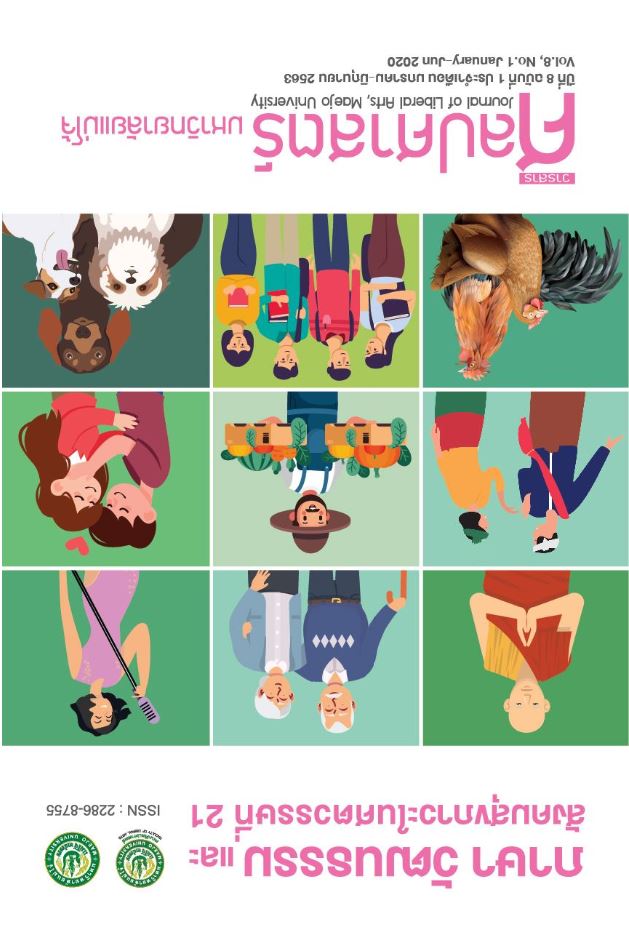แผนชุมชนเพื่อการจัดการสุนัขเลี้ยงปล่อยและสุนัขจรจัด ในเขตชุมชนเมือง กรณีศึกษาเทศบาลเมืองเพชรบูรณ์ จังหวัดเพชรบูรณ์
Main Article Content
บทคัดย่อ
งานวิจัยนี้ มีวัตถุประสงค์ 1) เพื่อศึกษาสภาพปัญหา อุปสรรค และความต้องการของประชาชนที่อาศัยอยู่ในเขตเทศบาลเมืองที่มีต่อสุนัขเลี้ยงปล่อยและสุนัขจรจัด และ 2) จัดทำแผนชุมชนต้นแบบนำร่องเพื่อการจัดการปัญหาสุนัขเลี้ยงปล่อยและสุนัขจรจัดในเขตเทศบาล โดยใช้ชุมชนในเขตเทศบาลเมืองเพชรบูรณ์ อำเภอเมืองเพชรบูรณ์ จังหวัดเพชรบูรณ์เป็นพื้นที่นำร่อง ในรูปแบบการวิจัยเชิงปฏิบัติการแบบมีส่วนร่วม ประกอบด้วย การประชุมเชิงปฏิบัติการ สัมภาษณ์เชิงลึก และสังเกตการณ์แบบมีส่วนร่วม จำแนกกลุ่มตัวอย่างออกเป็น 2 กลุ่ม คือ 1) เจ้าหน้าที่เทศบาล จำนวน 20 คน 2) ผู้มีส่วนได้ส่วนเสียจากชุมชนที่ 15 จำนวน 27 คน และชุมชนที่ 17 จำนวน 23 คน รวมทั้งสิ้น 70 คน ใช้แนวคำถามแบบกึ่งโครงสร้างเป็นเครื่องมือในการเก็บรวบรวมข้อมูล และนำมาวิเคราะห์เนื้อหาสร้างเป็นแผนชุมชนต้นแบบนำร่อง ผ่านกรอบแนวคิดการจัดการแบบพัวพัน (Engage Management) และการโค้ช(Coaching Approach) ผลการศึกษา พบว่า สภาพปัญหาอุปสรรค และความต้องการของประชาชนที่มีต่อสุนัขเลี้ยงปล่อยและสุนัขจรจัด มี 3 ระดับ คือ ระดับที่หนึ่ง ระดับปัจเจกบุคคล ได้แก่ ปัญหาขาดสำนึกสาธารณะ ขาดการลงมือปฏิบัติอย่างจริงจังเพื่อแก้ปัญหา ขาดความรู้สึกเป็นเจ้าของ ด้านความต้องการและความเดือดร้อนของปัจเจกบุคคล ประกอบด้วย โรคพิษสุนัขบ้า อุบัติเหตุจากสุนัข สุนัขกัด ความเดือดร้อนรำคาญจากเสียงและกลิ่นที่เกิดจากของเสียจากสุนัข ระดับที่สอง ได้แก่ ปัญหาระดับองค์กร ประกอบด้วย ช่องว่างและความซ้ำซ้อนของภารกิจ เพื่อขับเคลื่อนนโยบายไปสู่การปฏิบัติอย่างมีประสิทธิภาพ และระดับที่สาม ได้แก่ ปัญหาระดับโครงสร้าง ได้แก่ นโยบายและกฎหมายที่เป็นอุปสรรคต่อการปฏิบัติงานขององค์กรปกครองส่วนท้องถิ่นและหน่วยงานที่เกี่ยวข้อง ส่วนแผนชุมชนประกอบด้วยกลยุทธ์สำคัญ 3 ประการ คือ 1) การประมาณการประชากรสุนัขเลี้ยงปล่อยและสุนัขจรจัด 2) การพัฒนาระบบการกำกับดูแลที่มีประสิทธิภาพ ได้แก่ การศึกษาวิจัย การทำหมัน ทำวัคซีนป้องกันโรคพิษสุนัขบ้า และการขึ้นทะเบียนสุนัขทั้ง 3 ประเภท ได้แก่ สุนัขมีเจ้าของ สุนัขเลี้ยงปล่อย และสุนัขจรจัด และ 3) ระบบการบริหารจัดการแบบพัวพัน ได้แก่ การจัดทำธรรมนูญชุมชน การจัดตั้งชมรมหรือเครือข่ายจิตอาสา และโครงข่ายการสื่อสารแบบสายด่วนในเขตเทศบาลเมืองเพื่อการบริหารจัดการที่รวดเร็วกรณีเกิดเหตุฉุกเฉิน
Article Details
เอกสารอ้างอิง
ไทยรัฐออนไลน์. (2562). รถปลดทุกข์: ฝูงหมาจรจัดยึดพื้นที่บ่อขยะ จังหวัดเพชรบูรณ์. สืบค้น 20 ตุลาคม 2562, จาก https://www.thairath.co.th/clip/331820
ปศุสัตว์, กรม. (2559). รายงานสถานการณ์โรคพิษสุนัขบ้า ประจำปี 2559. สืบค้น 20 ตุลาคม 2562, จาก http://www.dld.go.th/th/index.php/th/newsflash/status-report/rabies-menu/report-rabies-menu
ปศุสัตว์, กรม. (2561). รายงานสถานการณ์โรคพิษสุนัขบ้า ประจำปี 2561. สืบค้น 20 ตุลาคม 2562, จาก http://www.dld.go.th/th/index.php/th/newsflash/status-report/rabies-menu/report-rabies-menu
ปาริชาติ วลัยเสถียร, สุทิตย์ อบอุ่น, พระมหา, สหัทยา วิเศษ, จันทนา เบญจทรัพย์ และชลกาญจน์ ฮาซันนารี. (2552). กระบวนการและเทคนิคการทำงานของนักพัฒนา. (พิมพ์ครั้งที่ 4). กรุงเทพฯ: โครงการเสริมสร้างการเรียนรู้เพื่อชุมชนเป็นสุข (สรส.).
พัชรินทร์ สิรสุนทร. (2563). การโค้ชกับการสื่อสารเชิงสัญญะเพื่อปรับเปลี่ยนวิถีชีวิตของกลุ่มเสี่ยงโรคเบาหวานและความดันโลหิตสูง. วารสารศิลปศาสตร์ มหาวิทยาลัยธรรมศาสตร์. 20(2).
สถานีโทรทัศน์ช่องเวิร์คพอยท์. (2561). ปศุสัตว์เพชรบูรณ์เร่งแก้ปัญหาสุนัขจรจัดบ่อขยะ หลังลักกินเป็ดไก่ชาวบ้าน. สืบค้น 20 ตุลาคม 2562, จาก https://workpointnews.com/2018/12/25/
สถานีโทรทัศน์พีพีทีวี. (2561). ชาวบ้านร้องสุนัขจรจัดกว่าสองพันตัวออกอาละวาด วอนหน่วยงานดูแล. สืบค้น 20 ตุลาคม 2562, จาก https://www.pptvhd36.com/news/ประเด็นร้อน/95459
สัญญา ยือราน และศิวิไลซ์ วนรัตน์วิจิตร. (2561). การวิจัยเชิงปฏิบัติการแบบมีส่วนร่วม สู่ความสำเร็จการเปลี่ยนแปลงนโยบายในระบบสุขภาพ. วารสารเครือข่ายวิทยาลัยพยาบาลและการสาธารณสุขภาคใต้. 5(2), 288-300.
สำนักข่าวไทย. (2561). ฝูงหมาจรจัดยึดพื้นที่ ชาวบ้านรอบบ่อขยะเพชรบูรณ์เดือดร้อนหนักวอนเร่งจัดการ (ข่าวส่วนภูมิภาค). สืบค้น 20 ตุลาคม 2562, จาก https://tna.mcot.net/view/5Dg5kne
สำนักข่าวสปริงนิวส์. (2561). ชาวบ้านวอนรัฐจัดการสุนัขกว่าสองพันตัวออกอาละวาด. สืบค้น 20 ตุลาคม 2562, จาก https://www.springnews.co.th/thailand/central/407498
สำนักข่าวอมรินทร์เทเลวิชั่น. (2561). ตะลึงฝูงหมาจรนับพันยึดถิ่น ชาวบ้านลากปืนยิงกัดไก่ยกเล้า วอนรัฐจัดการ. สืบค้น 20 ตุลาคม 2562, จาก https://www.amarintv.com/news-update/news-15375/313444/
อัจจนา ล่ำซำ, โสมรัศมิ์ จันทรัตน์ และชนกานต์ ฤทธินนท์. (2561). บริการทางการเงินของประเทศไทย: มุมมองเชิงพื้นที่จากข้อมูลจุดพิกัดกว่า 300,000 จุดทั่วประเทศ. สืบค้น 15 มีนาคม 2563, จาก https://www.pier. or.th/abridged.
Cortez-Aguirre, G. A., Jiménez-Coello, M., Gutiérrez-Blanco, E., & Ortega-Pacheco, A. (2018). Stray Dog Population in a City of Southern Mexico and Its Impact onthe Contamination of Public Areas. Hindawi: Veterinary Medicine International, 2018, 1-6. https://doi.org/10.1155/2018/2381 583.
Giddens, A. (2014). Giddens’ Theory of Structuration. London: Routledge.
Hallett, C. E. (1997). Learning through Reflection in the Community: The Relevance of Schon’s Theories of Coaching to Nursing Education. International Journal of Nursing Studies. 34(2), 103-110.
Kearsley, G., & Schneiderman, B. (1998). Engagement Theory: A Framework for Technology-based Learning and Teaching. Educational Technology Publications. 38(5), 20-23.
Kearsley, G., & Schneiderman, B. (1999). Engagement Theory: A Framework for Technology-Based Learning and Teaching. Retrieved from http://home.sprynet.com/~gkearsley/engage.htm
O’Brien, H. L., & Toms, E. G. (2008). What is user engagement? A Conceptual Framework for Defining User Engagement with Technology. Journal of the American Society for Information Science and Technology. 59(6), 938-955.
Peel, D. (2005). The Significance of Behavioral Learning Theory to the Development of Effective Coaching Practice. International Journal of Evidence Based Coaching and Mentoring. 3(1), 18-28.
Serag EI Din, H., Sharaby, A., Farouh, H. E., & Elariane, S. A. (2013). Principles of Urban Quality of Life for a Neighborhood. Housing and Building National Research Center Journal. 9, 86-92.
Sirasoonthorn, P. (2020). Lifestyle Coaching and a Salutogenic Model for Life Skill Development and Transferability for Diabetes and Hypertension Risk Groups, Thailand. International Journal of Education and Social Sciences Research. 3(3). http://dx.doi.org/10.37500/IJESSR.2020. 30224.
Zimmerman, M. A. (2019). Empowerment Theory: Psychological, Organizational and Community Levels of Analysis. Switzerland: Springer Nature.

